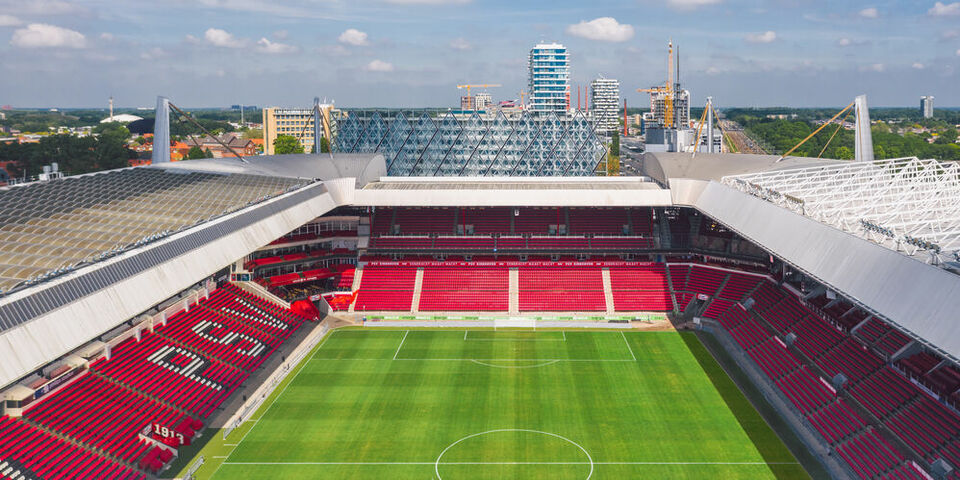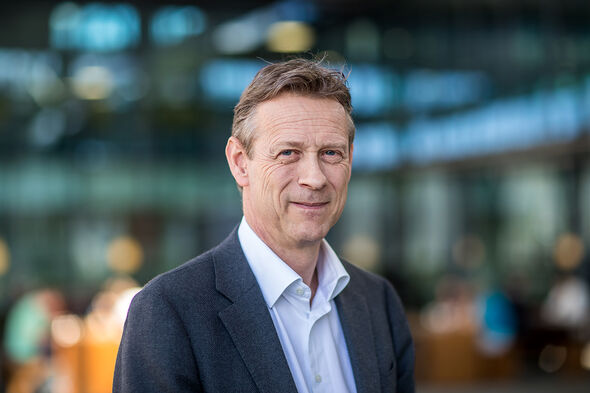Prof Talk | Jumping supporters in the PSV stadium
Seating for away fans in the Philips Stadion will be filled only to half capacity until further notice. This news was announced by PSV last week. The reason: research has shown that this section of the stand may be unable to withstand the impact of masses of supporters jumping up and down in unison. How do you establish something like this? And how can the structure be reinforced? Full professor of Sustainment of Concrete Structures Simon Wijte has been involved in the process of developing guidelines for the construction of soccer stadiums and other large, publicly accessible structures.
It was a heart-stopping moment in 2019 when the roof of the AZ stadium in Alkmaar collapsed. “After that, the Stadium Protocol was drawn up on the orders of the Ministry of the Interior,” tells Wijte, who complements his part-time professorship at TU/e with his role as board member of Hageman, a consultancy involved in the development of regulations necessitated by the protocol.
“People were thinking along the lines of the British ‘MOT’ for vehicles; making an annual structural inspection compulsory for stadiums and other buildings. We were still developing the guidelines when the incident in the NEC stadium in Nijmegen occurred.” There, a section of a stand collapsed in 2021. Caused by the crowd jumping to the same beat just where the structure was weak.
Bleachers
“At that time, one of the conclusions we had to draw was that the existing rules on loadbearing capacity in stadiums were likely too lax,” says Wijte, who also researched the collapse of a parking garage at Eindhoven Airport in 2017.
The capacity guideline is 4 kilonewton – about 400 kilograms – per square meter for a stand with seating. “When a stand has standing-room only, it was assumed that 5 kilonewton would be sufficient capacity. Initial studies showed that this capacity limit has to rise, perhaps to something like 8 kilonewton.” This is because supporters tend to push as close to the front of the stand as they can, especially when there’s something to celebrate. The crowd gathered on the steps nearest the pitch will exceed the numbers used in the calculations. If all these people then start jumping in unison, the forces they create will also exceed the calculated forces.
The PSV stadium has no standing-room, only seating. Which doesn’t mean to say that throughout an entire match the fans will be sitting quietly in their seats. Although Wijte reckons it does means they are less likely to surge en masse to the front – after all, they have to climb over rows of seats to do so.
Nonetheless, PSV is taking no risks now that research has brought to light the likely fragility of the construction of the section for away fans (pictured in the upper right corner). For the time being, this section of the stand will only be filled to half-capacity. And so, at yesterday’s match against FC Twente, away fans had to be disappointed.
Reinforcement
After the incidents in Alkmaar and Nijmegen many soccer clubs got the concrete structures in their stadiums checked. But how do you measure loadbearing capacity? Wijte – who stresses that he wasn’t involved in the PSV stadium study – explains.
“Heavy use or exposure to the elements are factors that can cause damage to certain structures, traffic bridges for example. In the case of a soccer stadium, however, these factors have little impact. And so the study will focus on the design – the construction plans – and its execution: are the reinforcements where they need to be?”
But how on earth do you establish this? “By using X-rays, radar or magnetism, you can get an image of where the reinforcements are. These are complex techniques, but they don’t damage the structure. And that’s a big point in their favor. Contrast this with another option: applying a test load. As you need to work with a sufficient margin compared to the actual load, this method can cause excessive cracking and lead to further damage.”
Carbon
PSV’s measure of halving the number of tickets they have available to away supporters is a temporary one. The construction of the away section will be reinforced, the Eindhoven club promises. The form these improvements will take – and what they will cost – is still under consideration.
What methods are available for making an existing concrete stand more robust? “The least invasive method is this one: affixing carbon fiber sheets to the underside using epoxy resin. Carbon has a high tensile strength, and when it’s carrying a load, it works in concert with the structure.” There are other, more rigorous, methods, concludes Wijte. “They involve replacing parts of the structure.”



Discussion